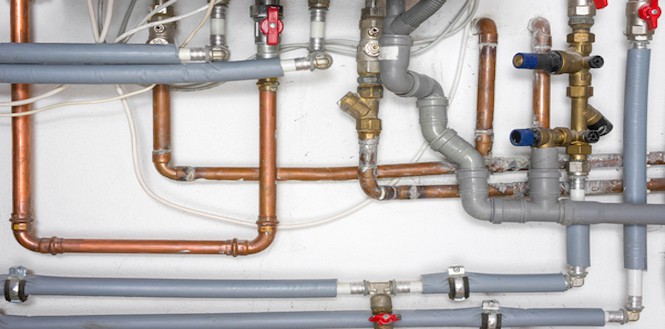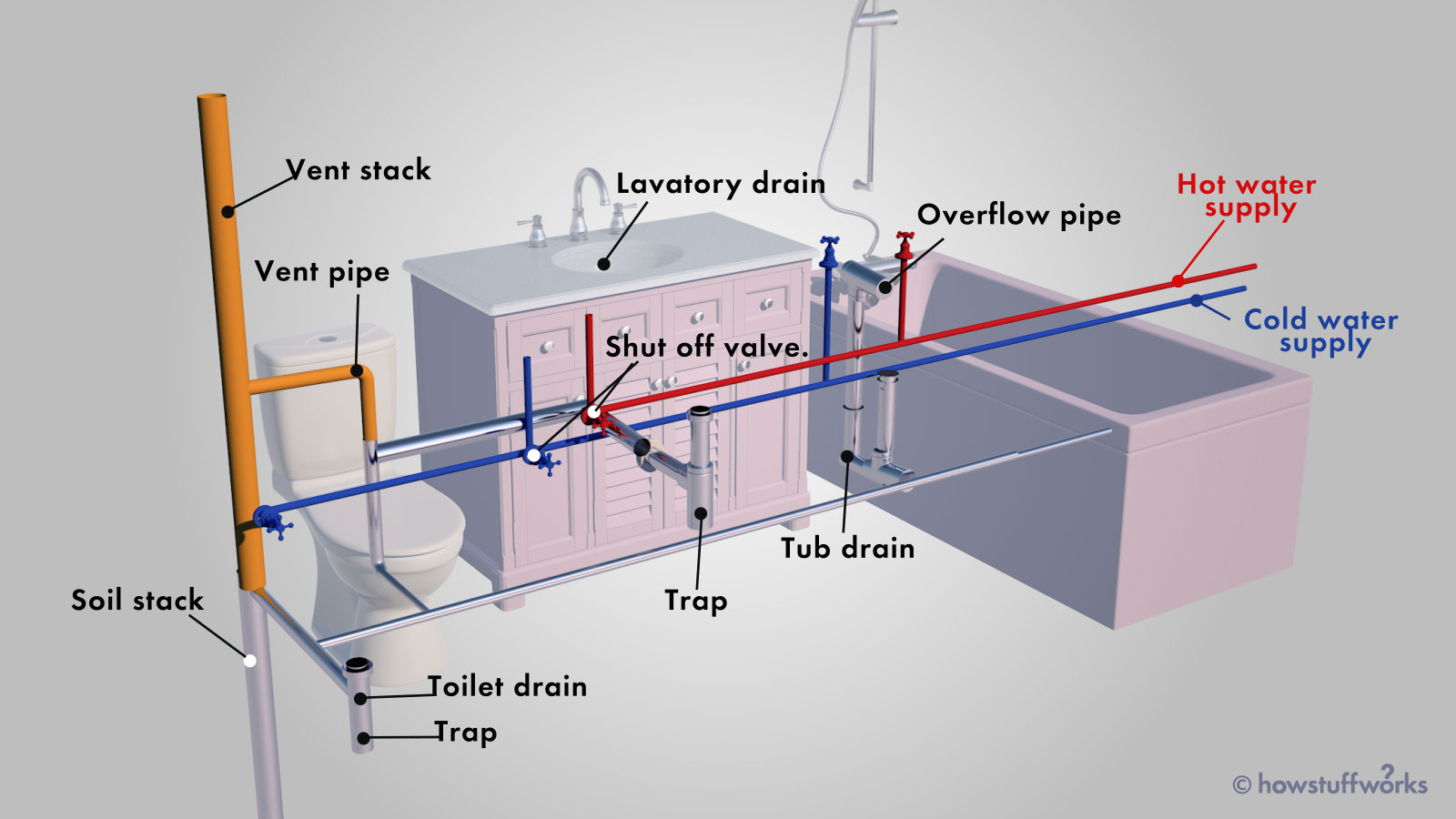The Main Elements of Your House's Plumbing System
The Main Elements of Your House's Plumbing System
Blog Article
Everyone has got his or her own conception with regards to Understanding Your Home's Plumbing Anatomy.

Understanding how your home's pipes system works is important for every homeowner. From delivering clean water for alcohol consumption, food preparation, and showering to safely eliminating wastewater, a properly maintained pipes system is crucial for your family's health and wellness and convenience. In this detailed overview, we'll discover the complex network that comprises your home's pipes and deal pointers on upkeep, upgrades, and taking care of usual concerns.
Intro
Your home's pipes system is greater than simply a network of pipelines; it's an intricate system that guarantees you have access to clean water and effective wastewater removal. Understanding its components and just how they work together can aid you protect against expensive repair work and guarantee every little thing runs efficiently.
Standard Elements of a Pipes System
Pipes and Tubing
At the heart of your plumbing system are the pipes and tubes that carry water throughout your home. These can be made of various products such as copper, PVC, or PEX, each with its benefits in terms of durability and cost-effectiveness.
Fixtures: Sinks, Toilets, Showers, and so on.
Components like sinks, bathrooms, showers, and tubs are where water is used in your house. Comprehending exactly how these fixtures attach to the pipes system assists in identifying troubles and preparing upgrades.
Valves and Shut-off Points
Shutoffs regulate the flow of water in your plumbing system. Shut-off shutoffs are critical throughout emergencies or when you need to make fixings, enabling you to isolate parts of the system without disrupting water circulation to the whole house.
Water Supply System
Key Water Line
The main water line attaches your home to the local supply of water or a private well. It's where water enters your home and is dispersed to different fixtures.
Water Meter and Stress Regulator
The water meter measures your water use, while a pressure regulator makes sure that water streams at a safe stress throughout your home's plumbing system, protecting against damage to pipes and components.
Cold Water vs. Hot Water Lines
Recognizing the distinction in between cold water lines, which supply water straight from the main, and warm water lines, which bring warmed water from the hot water heater, helps in repairing and planning for upgrades.
Drain System
Drain Pipes Pipeline and Traps
Drain pipes bring wastewater away from sinks, showers, and bathrooms to the sewer or septic system. Catches avoid sewage system gases from entering your home and likewise catch debris that can cause obstructions.
Ventilation Pipelines
Ventilation pipelines allow air into the water drainage system, protecting against suction that might reduce drain and cause catches to empty. Correct ventilation is crucial for preserving the honesty of your plumbing system.
Value of Proper Drain
Ensuring proper drain protects against back-ups and water damage. Consistently cleansing drains and preserving catches can avoid expensive repairs and prolong the life of your pipes system.
Water Heating System
Kinds Of Hot Water Heater
Hot water heater can be tankless or conventional tank-style. Tankless heating units warmth water on demand, while storage tanks save warmed water for immediate use.
Just How Water Heaters Attach to the Plumbing System
Comprehending exactly how hot water heater connect to both the cold water supply and hot water distribution lines helps in diagnosing issues like insufficient hot water or leaks.
Maintenance Tips for Water Heaters
Regularly purging your hot water heater to eliminate debris, inspecting the temperature level settings, and examining for leaks can prolong its life-span and boost power effectiveness.
Typical Plumbing Problems
Leaks and Their Causes
Leaks can happen because of maturing pipelines, loosened installations, or high water stress. Addressing leaks without delay prevents water damage and mold growth.
Clogs and Blockages
Clogs in drains and toilets are typically triggered by purging non-flushable products or an accumulation of oil and hair. Utilizing drain screens and being mindful of what decreases your drains can avoid blockages.
Indications of Plumbing Problems to Watch For
Low water pressure, slow drains, foul odors, or abnormally high water costs are indicators of possible pipes issues that must be dealt with without delay.
Pipes Upkeep Tips
Routine Assessments and Checks
Arrange annual plumbing inspections to capture concerns early. Try to find indications of leaks, corrosion, or mineral build-up in taps and showerheads.
Do It Yourself Upkeep Tasks
Easy tasks like cleaning faucet aerators, checking for commode leakages utilizing dye tablet computers, or protecting subjected pipes in cool environments can stop major plumbing concerns.
When to Call an Expert Plumbing
Know when a plumbing concern needs expert proficiency. Attempting intricate repair work without proper expertise can cause more damage and greater repair work costs.
Updating Your Plumbing System
Reasons for Upgrading
Updating to water-efficient fixtures or changing old pipelines can improve water top quality, lower water expenses, and enhance the worth of your home.
Modern Plumbing Technologies and Their Benefits
Check out technologies like clever leak detectors, water-saving toilets, and energy-efficient hot water heater that can save cash and decrease ecological effect.
Cost Factors To Consider and ROI
Calculate the ahead of time costs versus lasting cost savings when taking into consideration plumbing upgrades. Several upgrades pay for themselves via decreased energy bills and less repair work.
Ecological Impact and Preservation
Water-Saving Fixtures and Home Appliances
Installing low-flow taps, showerheads, and commodes can substantially reduce water usage without giving up performance.
Tips for Lowering Water Usage
Basic habits like fixing leaks without delay, taking shorter showers, and running complete loads of laundry and recipes can conserve water and lower your energy bills.
Eco-Friendly Plumbing Options
Take into consideration sustainable pipes products like bamboo for flooring, which is durable and environment-friendly, or recycled glass for kitchen counters.
Emergency Readiness
Steps to Take Throughout a Pipes Emergency
Know where your shut-off valves lie and just how to turn off the water system in case of a ruptured pipe or major leakage.
Relevance of Having Emergency Get In Touches With Helpful
Maintain contact info for neighborhood plumbers or emergency services conveniently offered for quick reaction during a pipes situation.
Do It Yourself Emergency Fixes (When Appropriate).
Momentary solutions like making use of duct tape to spot a dripping pipeline or placing a bucket under a leaking faucet can lessen damage up until an expert plumbing shows up.
Conclusion.
Understanding the anatomy of your home's plumbing system encourages you to keep it properly, conserving time and money on repair services. By adhering to regular maintenance regimens and remaining informed about contemporary pipes modern technologies, you can ensure your plumbing system operates effectively for several years to come.
Understanding Your Home Plumbing System: A Comprehensive Guide
Plumbing System: The Lifeline of Your Home
At its core, the plumbing system is designed to perform two primary functions: bring fresh water into your home and remove wastewater. The system is a network of pipes, fixtures, and other components that transport water and sewage. Residential plumbing systems include potable water supply lines, drain-waste-vent (DWV) systems, and various plumbing fixtures that make water use in daily tasks possible.
Key Components:
Water Supply: This part of your plumbing system brings municipal water into your home, passing through the main water supply line. It s responsible for supplying all water needs, from drinking to bathing.
Drainage System: It carries waste and water away from your home to the sewer or septic system. This system includes all the piping within your home that leads to external sewage or septic systems.
Vent System: An essential yet often overlooked component, the vent system allows sewer gases to escape and lets air into the drainpipes, ensuring water and waste move correctly through the system.
Fixture: More Than Just Taps and Toilets
Plumbing fixtures are the most interactive parts of the plumbing system, including faucets, showers, toilets, and sinks. Each fixture is connected to the plumbing system and plays a role in either the delivery of freshwater or the disposal of waste and wastewater.
Types of Fixtures:
Faucets and Sinks: Used for washing hands, dishes, and other daily water needs.
Toilets: Dispose of human waste through the sewage system.
Bathtubs and Showers: Provide bathing facilities, requiring both hot and cold water supply.
Water Supply: The Source of Life
The water supply system is a critical component, ensuring that potable water is available throughout your home for various uses, including drinking, cooking, and cleaning. This system consists of pipes that distribute water to different parts of the house, controlled by valves to regulate the water flow.
Types of Plumbing: Materials and Methods
Various types of plumbing systems and materials are used in residential settings, each with its advantages and applications. From copper and PVC pipes for water supply to cast iron and ABS for drainage, the choice of materials can impact the longevity and efficiency of your plumbing system.
https://intownplumbingtx.com/articles/home-plumbing-system-guide/

Understanding Your Home Plumbing System: A Comprehensive Guide
Plumbing System: The Lifeline of Your Home
At its core, the plumbing system is designed to perform two primary functions: bring fresh water into your home and remove wastewater. The system is a network of pipes, fixtures, and other components that transport water and sewage. Residential plumbing systems include potable water supply lines, drain-waste-vent (DWV) systems, and various plumbing fixtures that make water use in daily tasks possible.
Key Components:
Water Supply: This part of your plumbing system brings municipal water into your home, passing through the main water supply line. It s responsible for supplying all water needs, from drinking to bathing.
Drainage System: It carries waste and water away from your home to the sewer or septic system. This system includes all the piping within your home that leads to external sewage or septic systems.
Vent System: An essential yet often overlooked component, the vent system allows sewer gases to escape and lets air into the drainpipes, ensuring water and waste move correctly through the system.
Fixture: More Than Just Taps and Toilets
Plumbing fixtures are the most interactive parts of the plumbing system, including faucets, showers, toilets, and sinks. Each fixture is connected to the plumbing system and plays a role in either the delivery of freshwater or the disposal of waste and wastewater.
Types of Fixtures:
Water Supply: The Source of Life
The water supply system is a critical component, ensuring that potable water is available throughout your home for various uses, including drinking, cooking, and cleaning. This system consists of pipes that distribute water to different parts of the house, controlled by valves to regulate the water flow.
Types of Plumbing: Materials and Methods
Various types of plumbing systems and materials are used in residential settings, each with its advantages and applications. From copper and PVC pipes for water supply to cast iron and ABS for drainage, the choice of materials can impact the longevity and efficiency of your plumbing system.
https://intownplumbingtx.com/articles/home-plumbing-system-guide/
Do you appreciate reading about Understanding Your Home's Plumbing Anatomy? Create a short review below. We will be pleased to hear your opinion about this piece. We hope that you visit us again before long. Are you aware of somebody else who is interested by the topic? Please feel free to share it. We cherish reading our article about .
Book Instantly Report this page